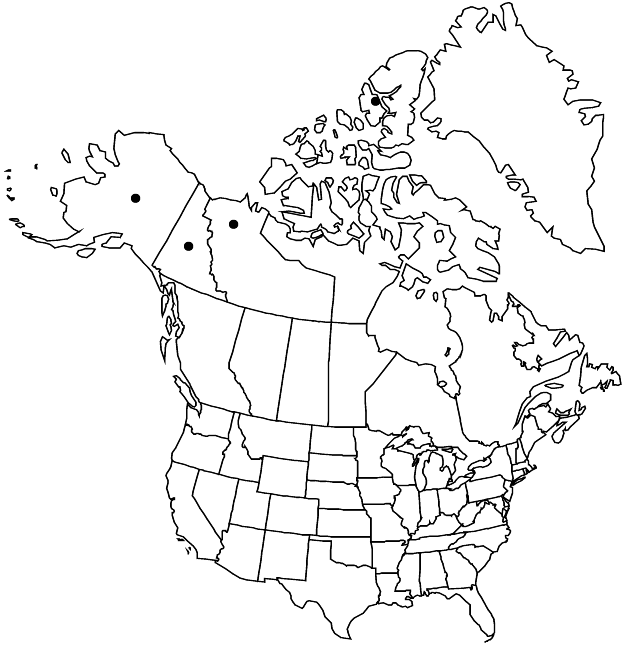Difference between revisions of "Polygonum humifusum subsp. caurianum"
Sida 20: 995. 2003.
FNA>Volume Importer |
FNA>Volume Importer |
||
| Line 11: | Line 11: | ||
|name=Polygonum caurianum | |name=Polygonum caurianum | ||
|authority=B. L. Robinson | |authority=B. L. Robinson | ||
| + | |rank=species | ||
|publication_title=Proc. Boston Soc. Nat. Hist. | |publication_title=Proc. Boston Soc. Nat. Hist. | ||
|publication_place=31: 264. 1904 | |publication_place=31: 264. 1904 | ||
| Line 29: | Line 30: | ||
|elevation=20-700 m | |elevation=20-700 m | ||
|distribution=N.W.T.;Nunavut;Yukon;Alaska. | |distribution=N.W.T.;Nunavut;Yukon;Alaska. | ||
| − | |discussion=<p><i>Polygonum humifusum</i> often has opposite proximal leaves. In North America, the closest relative of < | + | |discussion=<p><i>Polygonum humifusum</i> often has opposite proximal leaves. In North America, the closest relative of <i></i>subsp.<i> caurianum</i> is <i>P. fowleri</i>, rare individuals of which produce opposite leaves.</p><!-- |
--><p>Three specimens of the Asian subsp. humifusum were collected near Nanaimo, Vancouver Island, by J. Macoun in 1883 and 1887 (J. F. Brenckle 1941); the subspecies has not been recollected there. It has stems and leaves that are green, and achenes 2.1–2.7 mm, ± beaked, and exserted 0.9–1.3 mm from the perianth at maturity.</p> | --><p>Three specimens of the Asian subsp. humifusum were collected near Nanaimo, Vancouver Island, by J. Macoun in 1883 and 1887 (J. F. Brenckle 1941); the subspecies has not been recollected there. It has stems and leaves that are green, and achenes 2.1–2.7 mm, ± beaked, and exserted 0.9–1.3 mm from the perianth at maturity.</p> | ||
|tables= | |tables= | ||
| Line 39: | Line 40: | ||
-->{{#Taxon: | -->{{#Taxon: | ||
name=Polygonum humifusum subsp. caurianum | name=Polygonum humifusum subsp. caurianum | ||
| − | |||
|authority=(B. L. Robinson) Costea & Tardif | |authority=(B. L. Robinson) Costea & Tardif | ||
|rank=subspecies | |rank=subspecies | ||
| Line 54: | Line 54: | ||
|publication year=2003 | |publication year=2003 | ||
|special status= | |special status= | ||
| − | |source xml=https://jpend@bitbucket.org/aafc-mbb/fna-data-curation.git/src/ | + | |source xml=https://jpend@bitbucket.org/aafc-mbb/fna-data-curation.git/src/f50eec43f223ca0e34566be0b046453a0960e173/coarse_grained_fna_xml/V5/V5_1134.xml |
|subfamily=Polygonaceae subfam. Polygonoideae | |subfamily=Polygonaceae subfam. Polygonoideae | ||
|genus=Polygonum | |genus=Polygonum | ||
Revision as of 21:50, 16 December 2019
Plants frequently reddish or purplish tinged; homophyllous or, rarely, heterophyllous. Stems prostrate, often zigzagged, branched mostly from base, wiry, 2–20(–40) cm. Leaves often opposite at proximal nodes; ocrea 2–3(–4) mm, proximal part funnelform, distal part soon lacerate, nearly completely deciduous; petiole 1–3.4 mm; blade usually reddish or purple tinged, obovate to oblanceolate, 3–12(–25) × (1.5–)2.5–4.5(–8) mm, margins flat, apex rounded to obtuse; stem leaves 1–1.5(–2) times as long as adjacent branch leaves, distal leaves overtopping flowers. Inflorescences axillary; cymes ± uniformly distributed, 2–6-flowered. Pedicels enclosed in ocreae, 0.5–1.5 mm. Flowers closed or semi-open; perianth 1.5–2.3(–3) mm; tube 28–49% of perianth length; tepals partially overlapping, green, margins pink, rarely white, petaloid, not keeled, oblong, ± outcurved, usually not cucullate; midveins unbranched or branched; stamens 5. Achenes exserted from perianth, dark brown to purple, ovate-lanceolate, 2–3-gonous, 1.4–1.6(–2.2) mm, faces unequal, apex not beaked or obscurely beaked, edges straight or concave, shiny or dull, smooth to roughened; late-season achenes common, 2–3.5 mm.
Phenology: Flowering Jun–Aug.
Habitat: Gravel bars, waste places
Elevation: 20-700 m
Distribution

N.W.T., Nunavut, Yukon, Alaska.
Discussion
Polygonum humifusum often has opposite proximal leaves. In North America, the closest relative of subsp. caurianum is P. fowleri, rare individuals of which produce opposite leaves.
Three specimens of the Asian subsp. humifusum were collected near Nanaimo, Vancouver Island, by J. Macoun in 1883 and 1887 (J. F. Brenckle 1941); the subspecies has not been recollected there. It has stems and leaves that are green, and achenes 2.1–2.7 mm, ± beaked, and exserted 0.9–1.3 mm from the perianth at maturity.
Selected References
None.